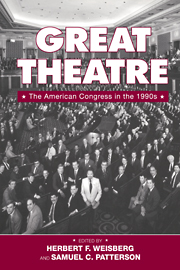Book contents
- Frontmatter
- Contents
- Figures and Tables
- Preface
- Contributors
- Introduction
- Congress and Its Audience
- 2 Representation in Congress: Line Drawing and Minorities
- 3 Unsympathetic Audience: Citizens' Evaluations of Congress
- 4 Back from Intermission: The 1994 Elections and the Return to Divided Government
- Congress at Play
- Congress and Other Actors
- Conclusion
- References
- Index
4 - Back from Intermission: The 1994 Elections and the Return to Divided Government
Published online by Cambridge University Press: 20 January 2010
- Frontmatter
- Contents
- Figures and Tables
- Preface
- Contributors
- Introduction
- Congress and Its Audience
- 2 Representation in Congress: Line Drawing and Minorities
- 3 Unsympathetic Audience: Citizens' Evaluations of Congress
- 4 Back from Intermission: The 1994 Elections and the Return to Divided Government
- Congress at Play
- Congress and Other Actors
- Conclusion
- References
- Index
Summary
More than a cast change occurred on November 8, 1994 – it was more like a simultaneous revolution and retrenchment. The revolution: Republicans seized control of both houses of Congress for the first time since the elections of 1952. The retrenchment: voters split control of the presidency and Congress between the two major political parties for the thirteenth time in the twenty-five post–World War II Congress and for the seventh time in the eight post-1980 Congress. Just when the 1992 presidential elections provided Americans a respite from divided government, the 1994 midterm elections brought it back in force, though with a twist that reversed a decades-old pattern. The 1994 and 1996 versions of divided government have a Democratic president and a Republican Congress.
The return to divided government raises the possibility that American voters like to split control of Congress and the presidency between the two parties. But the reversal in control – a Democrat in the White House and a Republican majority on Capitol Hill – undermines several prevailing theories of the causes of divided government (Jacobson 1990b; Petrocik 1991; Wattenberg 1991). The conventional wisdom on divided government, expressed in Gary Jacobson's book, The Electoral Origins of Divided Government (1990b), holds that Americans like a Republican president and a Democratic Congress. Jacobson argues that many voters believe Republicans perform best at managing the economy, keeping taxes low, and defending U.S. interests abroad while Democrats fare better at directing domestic programs and allocating tax dollars. Jacobson's theory became the conventional wisdom on divided government since the theory explained the only form of divided government Americans had witnessed since 1948: a Democratic Congress and a Republican president.
- Type
- Chapter
- Information
- Great TheatreThe American Congress in the 1990s, pp. 83 - 106Publisher: Cambridge University PressPrint publication year: 1998
- 4
- Cited by



